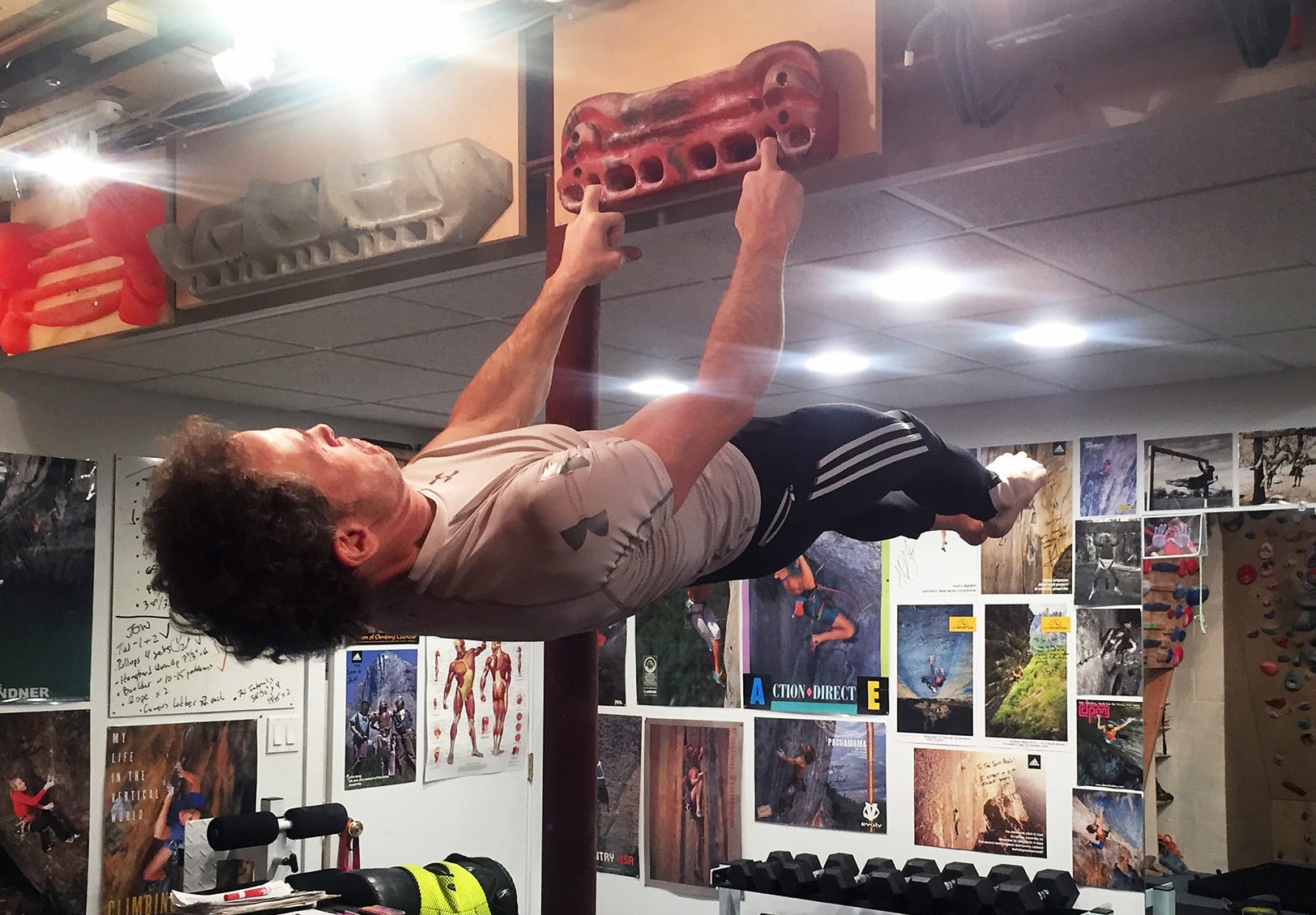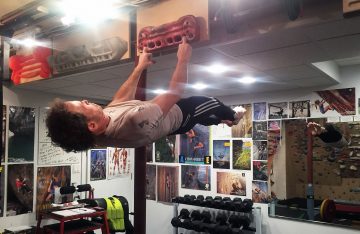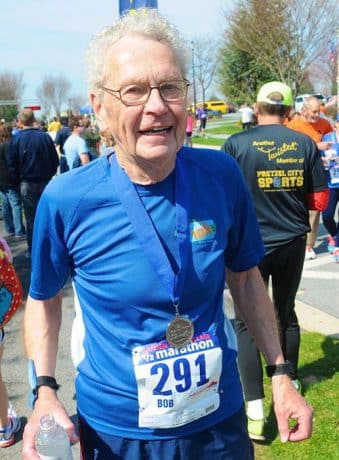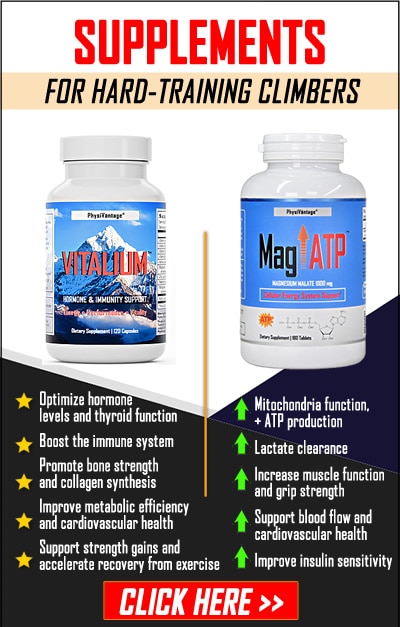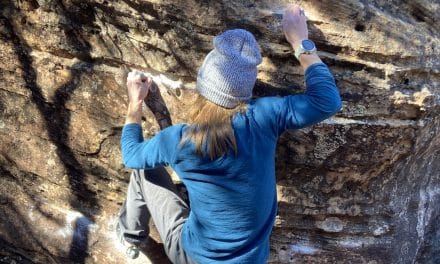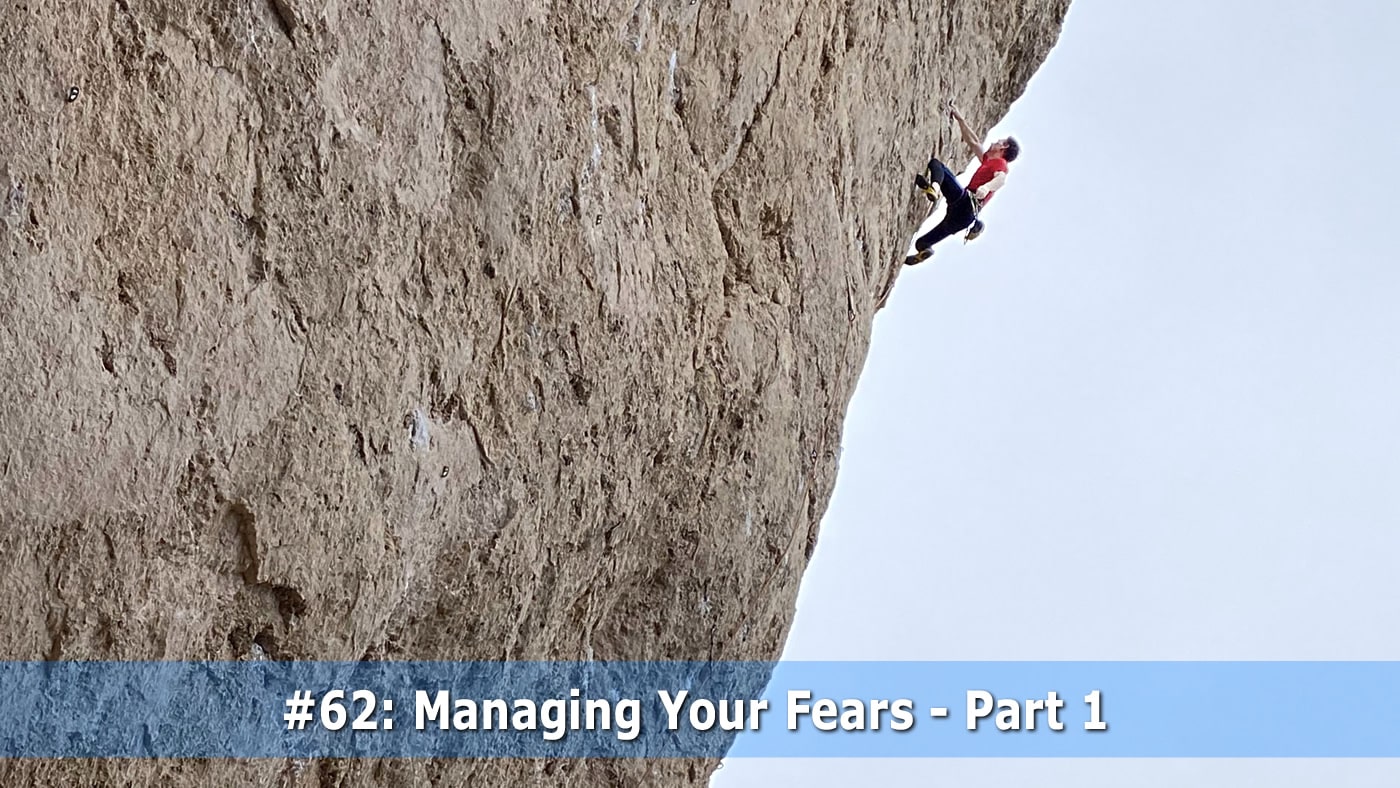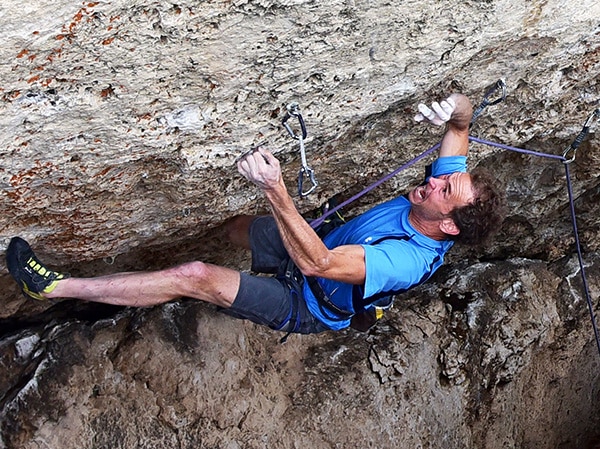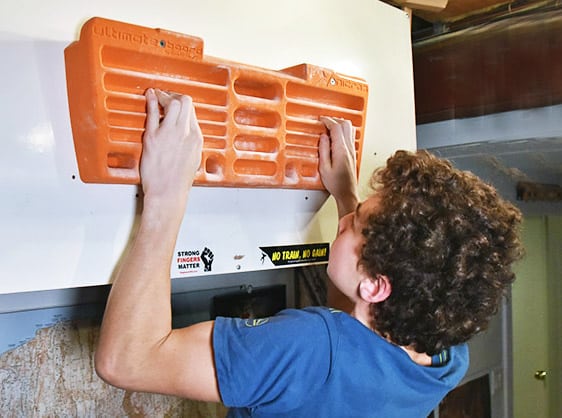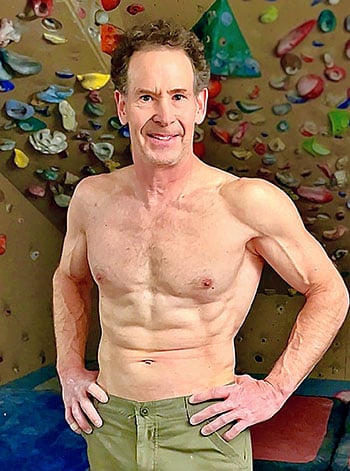
Eric Hörst (age 59) training in his home gym, Feb. 2023.
Aging doesn’t have to spell the end of your athleticism. How your body feels says more about your ability than the number of years to your name. The best master athletes believe that their best days are still ahead—and you can too!
(This article was originally published in February 2017, but Eric has refreshed it for this release on his 59th birthday!)
Today, I turned 59 years old. And I’m not complaining.
If you had asked me 25 years ago, I would have called 59 “over the hill”. Certainly too old for any serious athletic endeavors. Of course, our perspective—and wisdom—changes with life experience. Today, it’s my belief that I am the age I feel, not my chronological age. So today, I feel kind of 35ish.
But saying I feel 35 is more than a subjective sense of my mental state. Physically, I have objective proof that I’m performing at a level similar to the 30-something me from 25 years ago: I can still do a one-arm pull-up (on a good day), deadlift 300 pounds, hold a solid front lever, and climb mid-range 5.13. While none of these capabilities are world-class, they are proud achievements for a 59-year-old (and for many 35-year-olds as well). But I digress.
Age Isn’t Everything
My point is, while it’s fun to say that “age is simply a state of mind”, in reality how your body feels (and performs) ultimately determines your athletic ability. Your mental age (how old you subjectively feel) is largely determined by how physically capable you are, not the other way around. Thus, taking care of your body with regular exercise, a healthy diet, and quality sleep is central to feeling younger than your chronological age.
Mark Twain famously quipped that, “Age is an issue of mind over matter. If you don’t mind, it doesn’t matter.” Of course, each day alive on this third rock from the sun means there are very real biological aging processes (that matter in a big way) at work. Fortunately, many of these aging processes can be slowed with dedicated training and self-care. Trust me, dear reader: you can still achieve significant sport and fitness goals at age 50, 60, 70 and beyond!
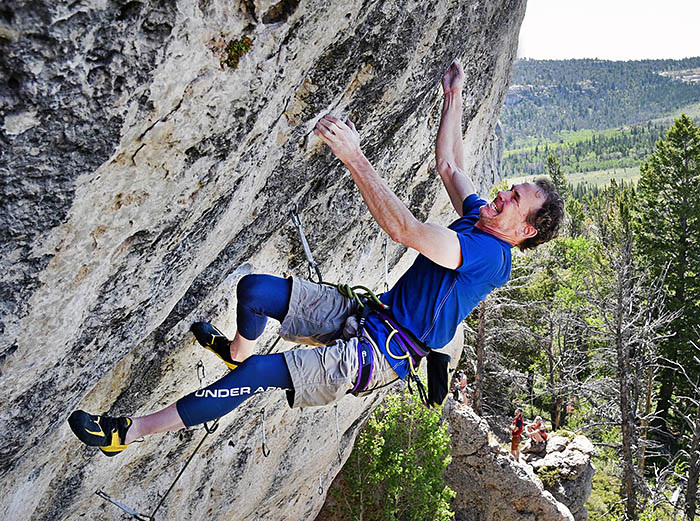
Aging Processes That Can Be Slowed with Training
There are many facets to age-related decline of physical and mental function. While some are genetic or disease-related (and perhaps unavoidable), many aging processes are natural/normal biological changes that you can exercise some influence over. Here are five that you can begin taking countermeasures against, today!
- Maximum oxygen uptake (VO2max) declines an average of 10% per decade after age 40, but research shows that regular aerobic training can reduce this decline to about 5% per decade. No matter your choice of aerobic activity (running, swimming, rowing, hiking), doing at least three 30-minute sessions per week will maintain a strong cardio-vascular system, improve mitochondria function, and boost stamina in all that you do.
- Sarcopenia is the age-related degenerative loss of skeletal muscle mass. Often beginning in your 30s, sarcopenia results in a decline of muscle strength at a rate of 0.5 – 1% per year, with up to 50% of muscle mass lost by the 8th decade of life. Sarcopenia is associated with acute and chronic disease states, increased insulin resistance, fatigue, falls, and mortality, and therefore every adult—athlete or not—should act to resist sarcopenia. It’s important to recognize that sarcopenia occurs mainly in Type II (fast-twitch) rather than Type I (slow-twitch) muscle fibers—therefore, aerobic activities (per above) will do little to combat age-related loss of muscle mass and strength. The battle against sarcopenia is fought in the weight room where the lifting of relatively heavy weighs recruits Type II muscles fibers and triggers the release of testosterone and growth hormone (which otherwise diminish with age), thus resulting in hypertrophy (increase in muscle mass).
- As we age, our brain and nervous system lose neurons resulting in declines in peripheral nerve function and diminished cognitive function (see next item). Neural drive, rate of force development in the muscles, and motor control all wane into the senior years, even in the absence of degenerative disease such as Parkinson’s. Engaging in powerful movements, such as sprinting and brisk lifting of light weights, and regularly challenging yourself with complex and novel movements, like dancing, climbing, or running an obstacle course, help maintain central nervous system function, sharpness of movement, reaction time, and neural drive.
- Cognitive decline is another unfortunate result of age-related central nervous system impairment. More serious problems like dementia and Alzheimer’s aside, everyone will experience a slight—but progressive—decline of mental sharpness and memory with advancing age (especially beyond age 60). Fortunately, this cognitive decline can be slowed by regularly engaging in challenging activities, especially those that require solving of novel problems. And if you are a coffee drinker like me, you’ll be happy to learn that a growing body of research shows that a morning cup of Joe (or three!) has a protective effect against cognitive impairment.
- Mitochondria are the power plants inside cells (which generate the ATP that fuels most cellular function), and so it’s not surprising that age-related decrease in physical performance, as well as many debilitating diseases, are accompanied by a precipitous decline in mitochondria function. Interestingly, there are only about 250 grams of ATP stored in the body, yet the daily turnover of ATP is estimated to be an incredible 70 kg (mostly via recycling of ADP). Obviously, then, the body must have a massive number of hard-working mitochondria (try about 10 quadrillion!) and any amount of mitochondria dysfunction can impact brain, muscle, and organ function. Not surprisingly, decline in mitochondria content is central to the aging process, as mitochondrion are damaged by free radicals but also lost as a result of disuse. Mitochondria are fortunately very plastic in that they become more efficient (even from a single aerobic workout) and, in fact, can increase aerobic capacity by 40% (in the working muscles) from just a month or two of regular aerobic exercise.
Your Thoughts About Aging Will Become a Self-Fulfilling Prophecy
Slowing these aging processes begins with the intention to make it happen, followed by the discipline to follow through with dedicated action. If you believe fighting the aging process is a futile battle, then you will surely be right! Similarly, if you only halfheartedly or infrequently engage in physical training then you’ll see little to no benefit. As with most things in life, it’s people with positive thoughts and a bias toward action that reap the best results….and will likely live the longest.
If there’s a secret to my success of staying is “good shape” into middle age, it’s my tendency toward compulsive planning and, thus, finding a way to fit in a workout even on the busiest days (I work full-time as the CEO of PhysiVāntage Nutrition). A few days per week I’m able to execute a comprehensive two-hour (or more) training-for-climbing workout, while on other more hectic days I may only have time for a 20-minute jog or a short interval workout on the track. Even on the busiest days, though, I try to escape the office to go for a walk outside while doing business phone calls! Ultimately, my exercise goal is to weight lift or rock climb a total of four days per week and to do some form of aerobic activity (running or Concept 2 rowing) three or four days per week. Once or twice per week I do a “two-a-day” workout consisting of both an aerobic and resistance training activity, and I do schedule one day of complete rest per week on Fridays.
The Power of Goals and Role Models
Staying motivated is hugely important to following through with a long-term exercise program and living an age-defying life. You can create leverage for daily action—even when you don’t feel like it—by setting goals and by having inspiring role models. Goals can be process or outcome oriented: a weight lift to achieve, a body weight target hit, a race time to beat, a cliff to climb, or a mountain to hike up or ski down. Whatever the goal is, it must be compelling and meaningful if it’s going to energize you in the long-term.
In a similar way, people can inspire you to become a better athlete (or anything). Having a role model that you aspire to emulate in some way can be hugely motivating. In the context of the aging athlete, I find great inspiration in seeing people who are older than me still pushing their limits and achieving greatly. A few examples include:
- Chuck Odette and Bill Ramsey climbing 5.14- after age 60!
- The late, great Stim Bullitt who was still climbing 5.10b at age 78
- Bob Hörst (yes, my father!) who at age 92 still runs (slowly) 2 to 3 miles, twice per week. As recently as age 85, Dad ran his third half-marathon!
So now I ask you: What are your goals? Who is your role model?
From there, set a few training (process) and performance goals to slow typical aging…..and get busy!
Fountain-of-Youth Training Tips
- Do some form of exercise every day. Even 10 to 15 minutes of brisk walking or a few laps on a nearby stairway will elevate your heart rate, increase oxygen flux, elevate your mood, and clear your mind.
- Do some form of resistance training at least 3 days per week. Weight lifting is best, but body weight exercises or machine training works well, too. Heavy multi-joint lifts, such as squats, deadlift, and the Olympic lifts, are best for lighting up the nervous system and stimulating testosterone and GH release.
- Do some form of aerobic activity at least 3 days per week. Make one of these days a sprint interval training session. Begin with 4 minutes of warm-up activity, then alternate between 30 seconds of all out effort (the “sprint”) and 90 seconds of light exercise (recovery). Continue in this interval training for 8 to 16 minutes. In aggregate, this 12 to 20 minutes of interval training is an incredibly time-efficient workout and one of the very best methods of triggering mitochondria biogenesis (the formation of new mitochondrion).
- Find a sport you enjoy and engage in this activity at least two days per week. Being involved in a sport you love makes for rich life experience and gives additional purpose to all of your other training.
- Eat a clean diet comprised of quality protein sources, plenty of vegetables and fruits, and a moderate amount of carbohydrate and healthy fats (important for hormone production). Avoid trans fats, fried (and fast) foods, refined sugar, and alcohol.
- Supplement with extra protein to achieve a daily total protein intake of between 0.75 gm – 1 gm per pound of body weight. My daily target is 120+ grams of protein, which I can achieve through normal meals and my practice of consuming 2 scoops of Supercharged Collagen before every resistance or climbing workout…and a Whey protein shake post-workout and sometimes before bed.
- Consume vital hormone-supporting micro-nutritents. Most folks are deficient on micro-nutrients essential for testosterone production, and so, especially an older athlete, it would be wise to take every day: 1000 IUs of Vitamin D (with K-2), 5 – 10mg Zinc, 150 – 450 mg of Magnesium; and every other day take 200mcg of Selenium, 6 mg of Boron and 6 mg of Copper.
- Strive to get 7+ hours of quality sleep per night (or 6.5 hours per night with a 30-minute mid-afternoon nap). Also important: Try to eliminate “bad stress” (stress related to unimportant activities or things out of your control). This gives you room to embrace moderate amounts of “good stress” (related to activities you care about).
Get an Annual Physical and Comprehensive Blood Panel
I don’t care that you “feel fine”…and that your schedule is “too busy.” Get an annual physical and blood panel, beginning at age 40…and absolutely every year after age 50. It might save your life!
Furthermore, there are many subtle “normal” changes that that can insidiously rob you of vim and vigor, strength and endurance, performance and exercise recovery, and joy and optimism. Accruing annual blood panels beginning at age 40 (actually, age 30 would be even better) provides a valuable track record of blood cell counts, lipid and hormone levels, among other things. As you progress through your 50s, 60s, and beyond, this data allow you (or your doctor) to recognize undesirable (health-, energy- and performance-harming) changes and empower you to take game-changing countermeasures (e.g. diet, exercise, pharmacological, and lifestyle).
If your insurance won’t pay for the blood work, then self-order (and self-pay) through a Website such as WalkInLab.com or UltaLabTests.com. Since age 55, I’ve been self-ordering the blood panels every 4 to 6 months to obtain a higher resolution of the physical changes taking place. I recommend the following blood test: Complete Blood Count (CBC), Comprehensive Metabolic Panel (CMP-14), Lipid Panel (with LDL:HDL ratio), Apolipoprotein B, Thyroid Panel (with TSH, Free T3, and Free T4), and Testosterone (Total T, Bioavailable T, and Free T). Total out-of-pocket costs for these tests is only ~$300 using the online labs named above. Do it!
Related Articles:
- How Much Does Age Really Matter?
- Training for Climbers Over Age 35
- The Role of Genetics on Climbing Performance…and What It Means for You
- Finger Training That you Can (and Should Do) Each Day!
- Connective Tissue Longevity and Health — the Role of Training & Nutrition
Copyright © 2000–2023 Eric J. Hörst | All Rights Reserved.

